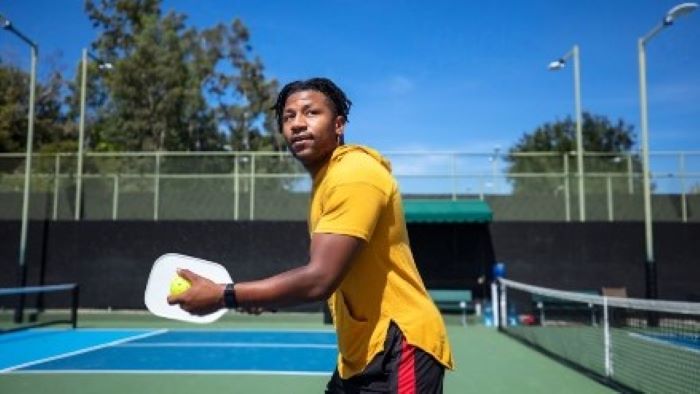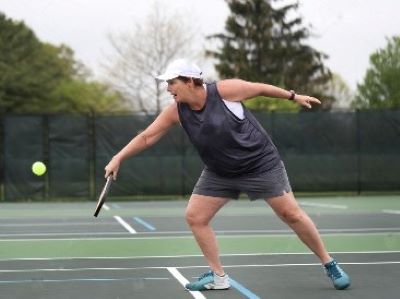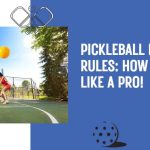If you’re someone who feels the thrill of pickleball, you know how challenging it can be. Pickleball incorporates aspects of tennis, badminton, and table tennis—allowing players to compete in either a gymnasium or an outdoor court.
Players of all skill sets must employ technical ability, strategy, and agility to succeed. One particularly challenging skill in pickleball is dealing with spin shots which are peculiar due to rotating the ball’s trajectory, speed, and place of bounce upon connection with the paddle.

Therefore, it can be challenging to defend against these shots. However, don’t be alarmed; this article will give some valuable tips that will help players defend against spin shots in pickleball. It will enhance their gaming experience on the court!
So start learning!
3 Tips to Defend Spin Shots Effectively in Pickleball
Here are some tips and strategies for defending spin shots in pickleball:
Tip 1: Watch Your Opponent’s Paddle Angle and Movement to Anticipate Spin Type and Direction
The first tip for defending spin shots is to watch your opponent’s paddle angle and movement before they hit the ball. Different paddle angles and movements can produce different types of spin, such as topspin, backspin, sidespin, or a combination of them. For example:
- If your opponent’s paddle moves from low to high with an open face, they are likely to hit a topspin shot that will make the ball bounce higher and faster.

- If your opponent’s paddle moves from high to low with a closed face, they are likely to hit a backspin shot that will make the ball bounce lower and slower.
- If your opponent’s paddle moves from left to right or right to left with a sideways motion, they are likely to hit a sidespin shot that will make the ball curve in the air and bounce sideways.
By reading the cues from your opponent’s paddle, you can anticipate the type and direction of spin and adjust your position and footwork accordingly. For example:
- If you expect a topspin shot, move back and prepare to hit the ball at its peak or on the way down.
- If you expect a backspin shot, you should move forward and prepare to hit the ball before it loses momentum or is on the way up.
- If you expect a sidespin shot, you should move sideways and prepare to hit the ball in front of your body or on the opposite side of the spin.
The key is to stay alert and focused on your opponent’s paddle and not get distracted by their body language or facial expressions.
Tip 2: Use a Firm Grip and a Solid Contact Point To Counteract the Spin Effect
The second tip for defending spin shots is to use a firm grip and a solid contact point when you hit the ball. A loose grip or a weak contact point can cause the ball to bounce unpredictably or fly out of bounds due to the spin effect. A firm grip and a solid contact point can help you control the ball and return it accurately and efficiently. For example:

- To counteract topspin, you should use a firm grip and hit the ball with a slightly closed face or a slice motion to reduce the bounce and add some backspin.
- To counteract backspin, you should use a firm grip and hit the ball with a slightly open face or a topspin motion to increase the bounce and add some topspin.
- To counteract sidespin, you should use a firm grip and hit the ball with a perpendicular face or a flat motion to neutralize the curve and add some straightness.
The key is to regularly practice this skill with a partner or a ball machine until you feel comfortable and confident with your grip and contact point.
Tip 3: Vary Your Returns and Keep Your Opponents Guessing
The third tip for defending spin shots is to vary your returns and keep your opponent guessing. Returning spin shots with the same pace, direction, or height can make you predictable and easy to attack by your opponent.
Varying returns can make it unpredictable and difficult to attack your opponent. For example:
- To vary your pace, you can return spin shots with more or less speed, depending on the situation. You can use more speed to put pressure on your opponent or catch them off, guard. You can use less speed to create angles or force them to generate their power.
- You can return spin shots with different angles depending on the situation to vary your direction. You can use cross-court shots to create more distance or open up the court. You can use down-the-line shots to surprise your opponent or close down the court.
- To vary your height, you can return spin shots with different trajectories depending on the situation. You can use high shots to give yourself more time or clear the net. You can use low shots to reduce your opponent’s time or hit the net.
You can also vary your returns by adding your spin to them. For example:
- You can return topspin shots with more topspin to make them bounce even higher and faster.
- You can return backspin shots with more backspin to make them bounce even lower and slower.
- You can return sidespin shots with more sidespin to make them curve even more in the air and bounce sideways.
The key is to be creative and adaptable in your game strategy and not let your opponent dictate the pace, direction, or height of the rally.
FAQs
You can counteract spin in pickleball by using a firm grip and a solid contact point when you hit the ball. You should also adjust your paddle angle and motion to match or oppose the type of spin on the ball.
Yes, you are allowed to put a spin on a pickleball as long as you do not violate any of the rules of the game. You can use spin to create more variety and challenge for your opponent.
You can return pickleball with a spin by adding your spin to the ball or by neutralizing the spin effect. You should also watch your opponent’s paddle angle and movement to anticipate the type and direction of spin and vary your returns accordingly.
Backspin is a type of spin that makes the ball rotate backward as it travels through the air. It causes the ball to bounce lower and slower than normal, making it difficult for your opponent to hit it. You can create a backspin by hitting the ball with a high-to-low motion and a closed paddle face.
Well, That’s a Wrap!
You have reached the end of this article on defending spin shots in pickleball. We hope you have learned something new and valuable from it.
By practicing the tips mentioned above, you can improve your pickleball skills and enjoy the game more. Remember, spin shots are not impossible to defend; they are just a challenge to overcome.
So don’t be afraid of spin shots; embrace them and have fun! Thank you for reading this article, and happy pickleballing!

I am a professional physiotherapist and the author of the BallSportsPro. I worked with athletes of all levels, from amateur to professional, and i helped them overcome injuries and improve their performance. I am a certified Pickleball instructor and has been playing the sport for over 10 years.


